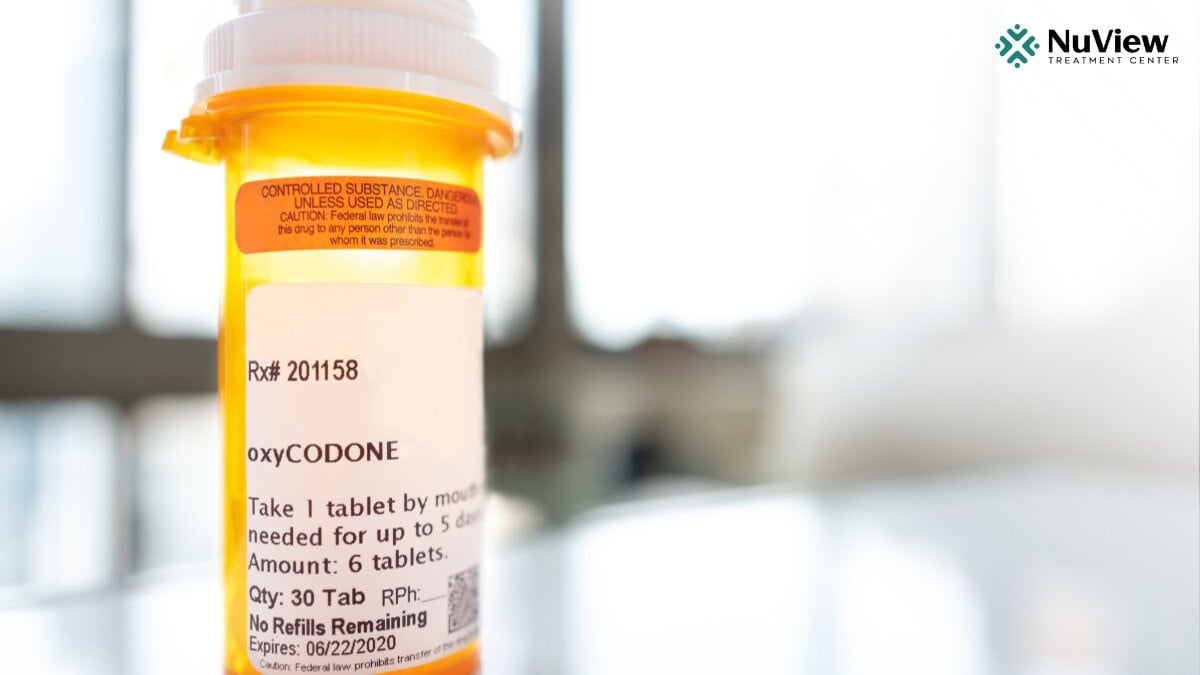Oxycodone is a generic opioid pain medication commonly sold under brand names like OxyContin, Oxaydo, Roxicodone, and Xtampza ER. While it is prescribed for pain relief purposes, as an opioid, it can be highly habit-forming.
If you have just been prescribed this opioid, you must be wondering how long oxycodone stays in the system, and this is the right question to ask, as it allows you to understand the risk of misuse and/or overdose, the detection window for drug tests, and even in seeking treatment.
Generally speaking, oxycodone stays in the system anywhere between 15 hours and 32.5 hours. However, depending on the type of drug test, it can be detectable for even longer.
What Is the Half-Life of Oxycodone?
The half-life of oxycodone is between 3 and 5 hours on average. The half-life refers to the time taken for oxycodone levels in your blood to drop by 50%. It takes several half-lives for oxycodone to be completely eliminated from your body.
Certain factors like dosage, frequency, metabolism, age, body weight and composition, and overall health can have an impact on how quickly or slowly oxycodone is eliminated from your system. Moreover, oxycodone comes in short-acting and long-acting formulations, which can have varying half-lives as follows:
- Short-acting/immediate-release oxycodone formulations: 3 - 5 hours.
- Long-acting/extended-release oxycodone formulations: 4.5 hours.
How Long Does Oxycodone Stay in the System?
While oxycodone can stay in the system anywhere between 15 to 32.5 hours, the different drug tests can detect it for varying periods of time.
How Long Does Oxycodone Stay in Your Urine?
Typically, oxycodone can be detected in your urine for 1 to 3 days after your last dose. However, it does depend on certain other factors like dosage and hydration levels. Higher doses can take longer to exit the body, while greater hydration levels can decrease the amount of time taken to detect oxycodone by diluting the urine.
Urine tests are the most commonly conducted tests to detect oxycodone, as they are easy to administer and cost-effective.
How Long Does Oxycodone Stay in Your Hair?
Oxycodone stays in your hair for the longest period of time, up to 90 days.
Hair tests have the longest detection window for oxycodone, but they are not as frequently used as urine tests. The reason being, your hair roots may test positive for the drug even weeks or months after you have stopped using it. However, when it comes to establishing a history of oxycodone use, hair tests can be useful.
How Long Does Oxycodone Stay in Your Saliva?
Oxycodone can be detected in your saliva for 1.5 days after your last dose.
Saliva tests are easy to administer and the least invasive. However, as oxycodone stays in the saliva for a shorter period of time than, say, urine, it is mainly used for immediate detection purposes, like with law enforcement.
How Long Does Oxycodone Stay in Your Blood?
Oxycodone can be detected in your blood for the shortest period of time, only 22 hours to be precise. Or 24 hours if we are stretching it.
Blood tests are minimally invasive and are not generally preferred to urine tests or saliva tests for detecting oxycodone, however, they can be very accurate. They come in quite useful in clinical settings.
Get Started With Nuview Treatment Center
Our dedicated professional staff is here to guide you or your loved one on the journey to lasting recovery, offering support every step of the way.
What Factors Affect How Long Does Oxycodone Stay in the System?
While oxycodone can be detected in your system for varying periods of time depending on the type of drug test used, here are the factors that generally affect how long does oxycodone stay in system:
- Formulation: Oxycodone comes in immediate-release and extended-release formulations. While immediate-release formulations are metabolized and eliminated from the body pretty quickly, the extended-release formulations might take a longer time.
- Metabolism: Metabolism is central to breaking down oxycodone and eliminating it from your body. A higher metabolism rate leads to quicker elimination. Therefore, maintaining physical activity and keeping your body hydrated is crucial.
- Genetics: Typically, oxycodone is broken down by liver enzymes CYP3A4 and CYP2D6. Depending on your genetics, you can have higher levels of it than others. Higher levels can quicken the rate at which oxycodone is eliminated from your body.
- Age: Age is one of the major factors affecting metabolism; with increasing age, metabolism slows down. So, among older persons, oxycodone can be metabolized and eliminated from the body at a slower rate.
- Liver and Kidney Functioning: Optimal liver and kidney functioning greatly matters when it comes to the elimination of oxycodone from your system, as it is mostly broken down by the liver and excreted by the kidneys. So, pre-existing liver or kidney conditions can hamper the rate at which oxycodone is eliminated from the body.
- Body Mass: Body mass once again affects the rate at which oxycodone is eliminated from your body through metabolism. Higher body mass may slow down this process.
How Long Does It Take for Oxycodone to Take Effect?
Oxycodone is quite a potent painkiller and is preferred because of its fast-acting mechanism. Its immediate-release formulations kick in within 10 - 30 minutes of intake, and extended-release formulations can take 1 hour to start working, however, their effects can linger for a longer time.
Once oxycodone takes effect, you might also feel relaxed, sleepy, and even euphoric. However, some might also experience side effects like changes in breathing/heart rate, nausea, allergic reactions, and constipation. If the side effects are intense, contact the doctor immediately.
Get Started With Nuview Treatment Center
Peak Levels of Oxycodone
Immediate-release oxycodone can peak within 1 hour after intake, which means it is at its most effective during this time. The effects of opioids linger for 6 hours, after which their blood concentration levels fall rapidly, and at this time, it is possible to experience withdrawal symptoms that can last up to a few days. On the contrary, extended-release oxycodone does not have a peak level.
Understanding Oxycodone Withdrawal Symptoms
Typically, oxycodone withdrawal symptoms can begin after 6 hours after your last dose. Within the first 4 days, the withdrawal symptoms are at their worst, and after this, they begin to improve. By 10 days, most withdrawal symptoms subside, except in cases where oxycodone has been misused to a great extent. This is when withdrawal symptoms can linger for weeks and months.
The common oxycodone withdrawal symptoms you need to be aware of are as follows:
- Anxiety
- Agitation
- Low mood
- Sleeping troubles
- Dilated pupils
- Tears and a runny nose
- Sweating
- Stomach ache
- Muscle pains
- Vomiting
- Diarrhea.
While most of these withdrawal symptoms will subside over a period of ten days, it is best to consult with your doctor/psychiatrist. If they linger for longer than this period, then it is an indication that you can benefit from further treatment.
Treatment Options for Oxycodone Abuse
Oxycodone, as an opioid, can be highly habit-forming with a potential for misuse and dependence. Therefore, it is vital that you stick to the dosage and frequency as prescribed by your doctor/psychiatrist. Nevertheless, if you are struggling with oxycodone misuse and/or dependence, then there are many treatment options available for you, and recovery is very much possible.
The treatment for oxycodone misuse and dependence is comprehensive and personalized, depending on your needs and goals. Typically, cognitive behavioral therapy (CBT), dialectical behavior therapy (DBT), and group therapy can be used.
Oxycodone abuse can be treated in outpatient settings, with a partial hospitalization program or intensive outpatient program, depending on the severity of the condition. However, for more severe cases, one may need more medically supervised detoxification (detox) and more intensive levels of care.
If you are struggling with oxycodone, we are here for you, without judgment and with care that works! Call NuView at (323) 307-7997 or email us at info@nuviewtreatment.com today!
Frequently Asked Questions (FAQs)
What is oxycodone?
Oxycodone is a generic opioid pain medication used for its pain-relieving properties. It is commonly sold under the brand names OxyContin, Oxaydo, OxyIR, Dazidox, Endocodone, Percolone, Roxicodone, and Xtampza ER, among others.
How does oxycodone work?
Oxycodone targets and activates opioid receptors in the brain and changes how pain signals are communicated from the brain to the body to reduce the experience of pain. Moreover, oxycodone is a CNS depressant and can produce feelings of a high, which is why it can be habit-forming.
What are the different types of oxycodone testing?
- Urine Tests: They can detect oxycodone for up to 3 days after the last dose.
- Hair Tests: They can detect oxycodone for up to 90 days after the last dose.
- Saliva Tests: They can detect oxycodone for up to 1.5 days after the last dose.
- Blood Tests: They can detect oxycodone for up to 22 hours after the last dose.
- What Is the Half-Life of Oxycodone?
- How Long Does Oxycodone Stay in the System?
- What Factors Affect How Long Does Oxycodone Stay in the System?
- How Long Does It Take for Oxycodone to Take Effect?
- Peak Levels of Oxycodone
- Understanding Oxycodone Withdrawal Symptoms
- Treatment Options for Oxycodone Abuse
- Frequently Asked Questions (FAQs)
- What Is the Half-Life of Oxycodone?
- How Long Does Oxycodone Stay in the System?
- What Factors Affect How Long Does Oxycodone Stay in the System?
- How Long Does It Take for Oxycodone to Take Effect?
- Peak Levels of Oxycodone
- Understanding Oxycodone Withdrawal Symptoms
- Treatment Options for Oxycodone Abuse
- Frequently Asked Questions (FAQs)
Get Help Today!
Everyone is Welcome Here and We All Have Your Back
Your healing journey deserves a personalized approach. At NuView, we integrate expertise in behavioral therapy, mental health, and substance use treatment to create a customized recovery plan tailored to your unique needs.
Connect with our Admissions Specialists today.







Written By
Dr. Ryan Peterson